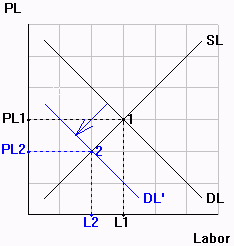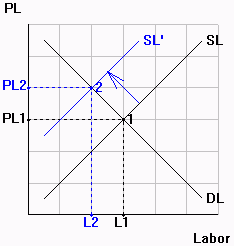Event: Employment falls in South Korea's shoe industry labor market after 1988


=> DL shifts left, as cheap foreign labor pulls the industry out
=> SL shifts left, as higher domestic wages push the industry out
| Jim Whitney |
Thursday, March 01, 2012 |
Dynamic effects of globalization:
Labor markets over time
This handout illustrates how,
with globalization, labor market conditions can motivate an industry to shift abroad for
two alternative reasons.
Example: consider the labor market for the shoe industry in
South Korea, a leading shoe exporter in 1988.
Event: Employment falls in South Korea's shoe industry labor market after 1988 |
|
| Case 1 | Case 2 |
 |
 |
| Case 1: Lower wages abroad => DL shifts left, as cheap foreign labor pulls the industry out |
Case 2: Higher wages at home => SL shifts left, as higher domestic wages push the industry out |
Case 1 is most common
when previously isolated countries globalize.
It occurs because we are not yet a fully globalized economy
An example: China's recent entry into the WTO and the decision to end
global quota restrictions on textiles causes a shift of textile production from
Mexico to China, putting downward pressure on wages in Mexico as labor demand shrinks in
Mexico's textile industry.
Lower wages in China pull textile firms out of Mexico. Demand for labor
falls (a shift of demand).
Case 2 is most common
when already globalized countries grow.
It occurs continuously as countries develop in a globalized economy.
An example: South Korea's rapid growth under its export-led
industrialization (ELI) helps the country's workers become more productive and better
suited for higher-skilled opportunities in other industries, putting upward pressure on
shoe industry wages as the industry's labor supply shrinks.
Higher wages in South Korea push shoe firms out. Quantity demanded of
labor falls (a movement along demand).